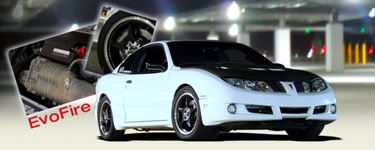I'm not sure if anyone on this site is this into suspension but I figured I'd give it a shot.
Is there anywhere that sells roll center correcting ball joints for our cars? My car rides 5" off the ground and I had a huge roll couple, so I have been hacking up the spindles and rewelding the lower ball joint piece lower to correct it. Its worked great but I'd like some more adjustability and something not so macgyver'd.
Just curious if there was anything out there or what you guys where using to correct it, or are you guys all rolling around with effed up control arm angles

Thanks

most people say that control arms parallel to the ground yields the best results.

EVOFire {DesertTuners} wrote:most people say that control arms parallel to the ground yields the best results.
Always, if your goal is controlled and consistent suspension articulation with an effort to limit bump steer and decrease roll.
"Never argue with an idiot. They'll drag you down to their level, then beat you with experience!" -Anonymous
As soon as you lower the car they aren't, they point upwards.
Also I know just about everyone says that level control arms are ideal, but i dissagree and here is why.
Say your control arm balljoint is closer to the ground than your inner pivot points, resulting in a downward pointing control arm. When in compression the control arm will level out and actually get longer gaining you negative camber helping the tires contact patch on the ground.
If you have a control arm that is already paralell to the ground, when you take a corner the ball joint will rise in comparison to the inner pivot points resulting in an upward pointing control arm. When this happens the control arm gets shorter and creates positve camber (pulling the bottom of the wheel inwards) and the tire losses grip cause your only running on the outside edge.
Also not to mention a slight downward angle to the control arm results in a smaller roll couple, which basically means your roll center is closer to your center of gravity which is the desired result when adjusting roll center.
Of course you can go to far and if you have a wicked angle to your control arms they will never level out in cornering, so there is a fine line there that takes some testing and tuning to find.
Also the angle of the physical control arm dosent matter, its the invisable line between the center of the inner bolt the control arm pivots off and the balljoint centerline. I've measured it up and when your control arms are level, they actually have a slight down ward angle to them if you go by the invisible line, which is all that matters.
But i didnt start this topic to talk about suspension geometry, I was just curious if there was anything out there to adjust it or what you guys where doing to correct it.

Mr_Efficiency (Tyrin) wrote:As soon as you lower the car they aren't, they point upwards.
I'm lowered quite a bit and they are level.
Mr_Efficiency (Tyrin) wrote:Say your control arm balljoint is closer to the ground than your inner pivot points, resulting in a downward pointing control arm. When in compression the control arm will level out and actually get longer gaining you negative camber helping the tires contact patch on the ground.
If you have a control arm that is already paralell to the ground, when you take a corner the ball joint will rise in comparison to the inner pivot points resulting in an upward pointing control arm. When this happens the control arm gets shorter and creates positve camber (pulling the bottom of the wheel inwards) and the tire losses grip cause your only running on the outside edge.
Also not to mention a slight downward angle to the control arm results in a smaller roll couple, which basically means your roll center is closer to your center of gravity which is the desired result when adjusting roll center.
Sway bars are your friend. Also, struts do more for controlling roll than any other part of the suspension in our cars, get some good ones.
Mr_Efficiency (Tyrin) wrote:Of course you can go to far and if you have a wicked angle to your control arms they will never level out in cornering, so there is a fine line there that takes some testing and tuning to find.
If you are setup to actually do the turns that could even possibly create such forces you will not ever have said angles.
Mr_Efficiency (Tyrin) wrote:Also the angle of the physical control arm dosent matter, its the invisable line between the center of the inner bolt the control arm pivots off and the balljoint centerline. I've measured it up and when your control arms are level, they actually have a slight down ward angle to them if you go by the invisible line, which is all that matters.
Your knuckle can pivot on the lower ball joint, right. But what your missing is the load translation, the load is translated to the control arm bushings directly from the ball joint flange. If it is loaded at an angle then you will get the higher roll forces, if they are applied parallel you will not induce any roll at all. The control arm will not support a torque to be translated through it, the strut takes all of that itself. This is the advantage to the ball joints, any torque you try to apply thru them gets turned over to the struts thru the knuckle and only the lateral forces are translated. If you did a FBD on the CA it would create no torque load at all if it was parallel....can be no other argument.
Mr_Efficiency (Tyrin) wrote:But i didnt start this topic to talk about suspension geometry, I was just curious if there was anything out there to adjust it or what you guys where doing to correct it.
Hey man, I think you brought it up first. Getting on here and spreading dumb crap that isn't true. \/
Mr_Efficiency (Tyrin) wrote:My car rides 5" off the ground and I had a huge roll couple, so I have been hacking up the spindles and rewelding the lower ball joint piece lower to correct it. Its worked great but I'd like some more adjustability and something not so macgyver'd.
Just curious if there was anything out there or what you guys where using to correct it, or are you guys all rolling around with effed up control arm angles
To answer your question , no, nobody makes them. I guess you gotta keep welding....

"Never argue with an idiot. They'll drag you down to their level, then beat you with experience!" -Anonymous
I thought our factory ride hight was roughly 5" already?

I stand by what said, I dont doubt your control arm angles are correct. I just know mine are screwed and I had a look at my stock 97 and they where almost paralell so I figured you guys must have them upwards. also my friends 99 with 17's and lowering springs has the control arms pointing up as well.
Also I used to run a 21mm sway bar but its to stiff and causes a huge push, i had to go back to the 17mm but now since i have more roll its killing my camber curve. Bigger sway bars dont quite have the same effect on a banked oval as they do on the street.
Thanks for answering my question tho.
And I dont know about factory ride height, but with stock suspension my car is 6 1/2 inches off the ground with 195/60/14's on it. I'd imagine stock would be higher given the larger tire.... then again my car only weighs 2200 pounds with me in it, so that would probly add some height as well.

My 98 is lowered approx. 1.5" and the control arms are just about parallel. They have an ever so slight downward angle to them.







